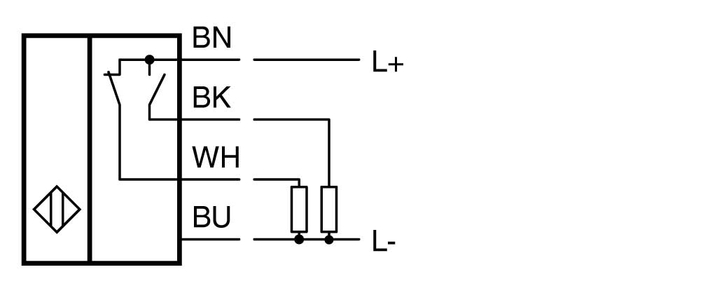Output Logic of Switching Magnetic Field Sensors
Switching Element Function of the Sensor

Switching sensors have a binary output logic. The output knows only the two states "active" and "inactive" or "on" and "off." The switching element function determines whether a magnetic field sensor closes or opens the output when the object is detected, or whether this can be freely selected depending on the intended purpose.
NO Contact (Normally Open—State of Unactuated Switch)
Electronic switching element function of a magnetic field sensor: switching output logic. When the switching condition is fulfilled (e.g., the magnetic field sensor detects an object in the switching range), the output is closed, meaning the current flows. When idle, the output is open, meaning no current flows.

Example of Normally Open (NO)
Complementary
Electronic switching element function of a magnetic field sensor. A complementary magnetic field sensor features two integrated switching output stages—one designed as a "normally-open" type of output and the other as a "normally-closed" type of output.
Complementary sensors can be used to reduce the variety of sensor types in the plant, thereby reducing storage requirements. Mostly, the complementary design of the switching output stages is used for diagnostic purposes. A plausible output logic for the sensor is only possible if the two switching outputs have opposing states. If they have the same state, this is a sign of an error, e.g., lead breakage or lead short circuit.

Complementary—Example
Repeat Accuracy
According to EN 60947-5-2, the repeat accuracy is the deviation value of the effective operating distance (sr) under set conditions. The value defines the switch point accuracy of successive switching events over a period of eight hours at an ambient temperature of +23 °C ±5 °C and at a constant operating voltage.
Switching Hysteresis
According to EN 60947-5-2, the hysteresis (H) is the distance between the switch-on point when the damping element approaches the proximity sensor and the switch-off point when it moves away from the proximity sensor. The switching hysteresis H is specified relative to the effective operating distance sr, measured at an ambient temperature of +23 °C ±5 °C and the rated operating voltage.
H < 0.2 * sr
Proximity sensors from Pepperl+Fuchs typically have a hysteresis of 5 %.








 +886 2 27227708
+886 2 27227708